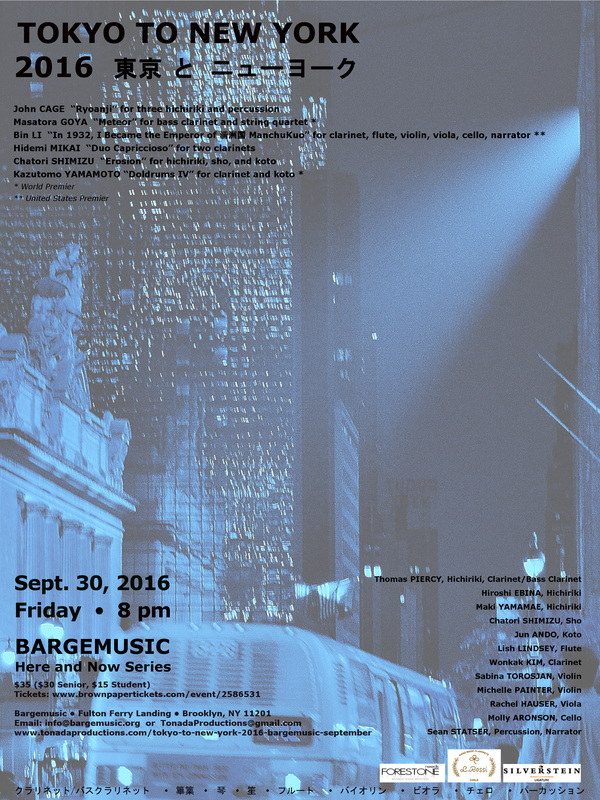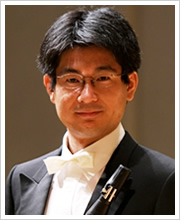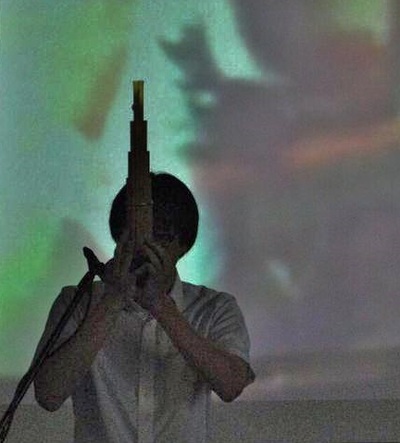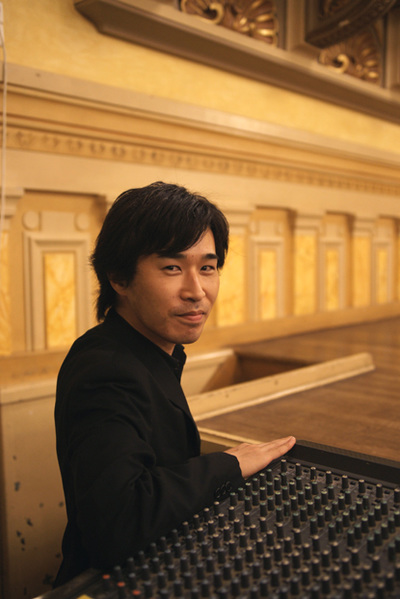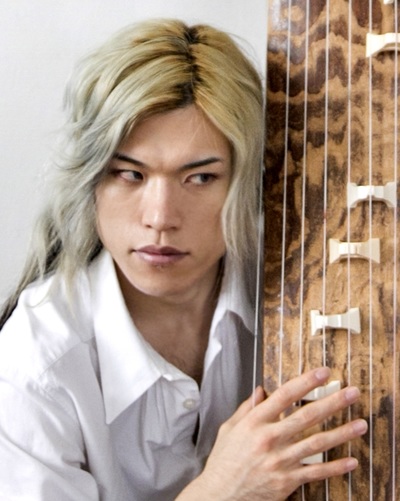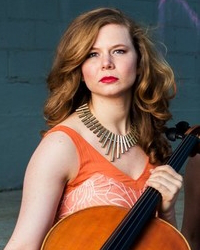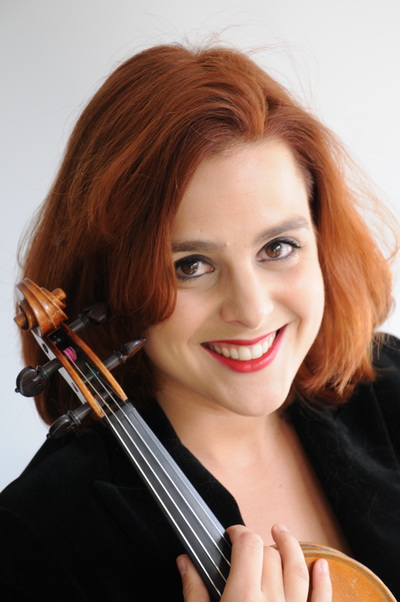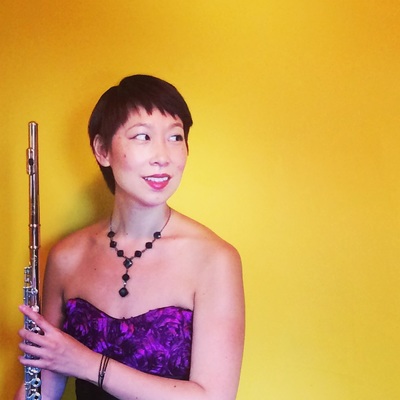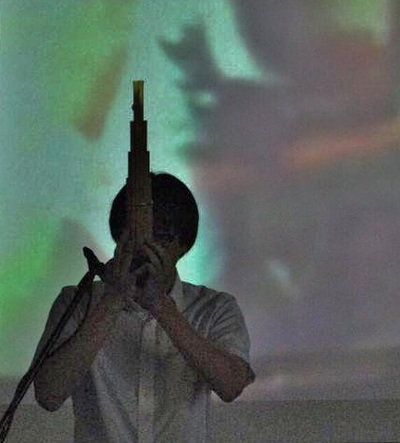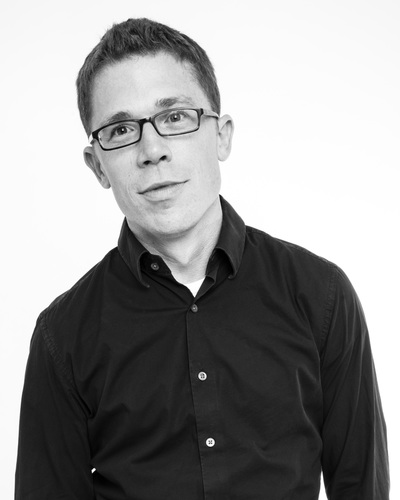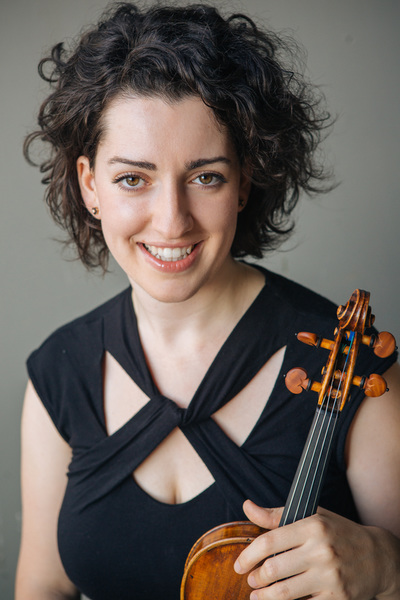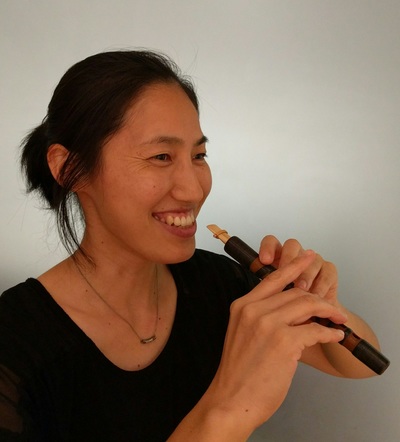篳篥 クラリネット バスクラリネット 琴 フルート 笙 バイオリン ビオラ チェロ パーカッション
|
John CAGE
Masatora GOYA Bin LI Hidemi MIKAI Chatori SHIMIZU Kazutomo YAMAMOTO |
“Ryoanji” for three hichiriki and percussion
“Meteor” for bass clarinet and string quartet (World Premiere) “In 1932, I Became the Emperor of 满洲国 ManchuKuo” - flute, clarinet, violin, viola, cello, narrator (U.S. Premiere) “Duo Capriccioso” for two clarinets “Erosion” for hichiriki, sho, and koto “Doldrums IV” for clarinet and koto (World Premiere) |
|
TOKYO TO NEW YORK 東京 と ニューヨーク
BARGEMUSIC - Here and Now Series September 30, 2016 • Friday, 8 pm $35 ($30 Senior, $15 Student) Bargemusic 1 Water St., Brooklyn, NY 11201 718.624.4924 [email protected] [email protected] www.bargemusic.org Directions: www.bargemusic.org/directions.html Tickets: www.brownpapertickets.com/event/2586531
|
"Tokyo to New York” celebrates the connections between Tokyo and New York City with a series of concerts in Tokyo and New York. The concerts feature new works composed for Western classical instruments as well as traditional Japanese instruments. They include a wide variety of styles of music, from Japanese avant-garde to contemporary classical, abstract to minimalism, J-pop to jazz-influenced pieces. The composers have ranged from 19 to 92 years of age. They come from all walks of life and experience: from university students to university professors; from self-taught composers to composers with advanced degrees; from emerging composers to composers that have won such prominent awards as the Takemitsu Prize, Grammy Award, Latin Grammy Award, and the Pulitzer Prize. The musicians of “Tokyo to New York” have had the opportunity to work with many of the Japanese and American composers programmed in these concerts, and since 2012, “Tokyo to New York” has performed over 60 world premiers and numerous Japan and United States Premiers.
The New York Times selected “Tokyo to New York” concerts as a critics’ concert of the week; NYClassical Review wrote of a “Tokyo to New York” concert as a season highlight; and a review from Lucid Culture Magazine described a “Tokyo to New York” concert as "…a fascinatingly eclectic, virtuosic program of new chamber works."
Composers (L to R): John CAGE, Masatora GOYA, Bin LI, Hidemi MIKAI, Chatori SHIMIZU, Kazutomo YAMAMOTO
Performers (Top L to R): Jun ANDO, Molly ARONSON, Hiroshi EBINA, Rachel HAUSER, Wonkak KIM, Lish Lindsey
(Bottom L to R): Michelle PAINTER, Thomas PIERCY, Chatori SHIMIZU, Sean STATSER, Sabina TOROSJAN, Maki YAMAMAE
(Bottom L to R): Michelle PAINTER, Thomas PIERCY, Chatori SHIMIZU, Sean STATSER, Sabina TOROSJAN, Maki YAMAMAE
PROGRAM NOTES
John CAGE
“Ryoanji” (1983-1985)
In 1983, Cage began a composition called “Ryoanji” named after the rock garden in Kyoto, Japan. This garden is a collection of 15 rocks, placed in a landscape of raked, white sand. In the summer of 1983, Cage started a series of drawings entitled Where R=Ryoanji, using (by drawing around) 15 different stones. Around the same time, the oboist James Ostryniec asked Cage to write a piece for him, which resulted in the piece “Ryoanji.” Originally composed for oboe, “Ryoanji” was arranged by the composer for other instruments and has since been performed for any number of instruments. “Ryoanji” is a series of 8 songs. A song is created on 2 pages, each of which contains 2 rectangular systems. In each rectangle, Cage traced parts of the perimeters of the given stones. These curves are played as glissandi. In some places, contours overlap, thus making materials impossible to play. In this case, a tape recording is used, or two other players join in, resulting in a duet or trio. The solo (or trio) is always accompanied by a percussion part or a similar 20 member orchestral part. The percussion part is 2 unspecified sounds, played on wood and metal. The hichiriki players represent the stones of the garden, the percussionist the raked sand.
Masatora GOYA
"Meteor" for bass clarinet and string quartet (2016) (World Premier)
We recognize meteors only when they visit us as shooting stars; the final moment of them in flames. One day I thought about their journey of traveling all the way in the dark space by themselves, being caught by the gravity of the Earth, and flaming up to pieces before they hit the ground. The cinematic vision kept haunting me since, and here is my attempt to capture it in music. “Meteor" was composed in 2016 and dedicated to Thomas Piercy.
Bin LI
“In 1932, I Became the Emperor of 满洲国 ManchuKuo” for narrator, clarinet, flute, violin, viola, cello (2015-2016) (U.S. Premier)
Text by Asher Ross
“...mixing
Memory and desire, stirring
Dull roots with spring rain.”
T.S. Eliot
Program note from the writer Asher Ross:
Thematically, this piece has two musico-historical points of focus; The Internationale and the anthem of the Qing dynasty, the last ruling house of China. The latter was composed and adopted in 1911, during the third year of the reign of Puyi, who submitted to abdication only six days later. The melodies conjure a moment when one of the world's great civilizations was on the verge of transformation, yet the spirit of the piece is not to be found in these feelings alone.
When the composer first asked me to draft a brief text concerning the life of Puyi, he told me that as a child in China The Internationale was often sung to him as a lullaby. This ran against my every association, uprooting so many violent, tumultuous images of the 20th century and supplanting them momentarily with a vision of a dreaming child.
For all his sins, betrayals, cruelties and self-interest, the last emperor of China, Puyi, was also an ineffectual dreamer. It is true that he was led on by a passionate desire to restore the glory of the Qing, but Puyi was a child-emperor. For him this was perhaps also a desire to restore the world of his origins, a desire that is universal, and universally thwarted.
Historical Note:
Puyi ascended the throne at the age of two in December, 1908. The toddler was moved to the Forbidden City, where his life was governed by eunuchs, servants and tutors. As he grew he would regularly have beatings administered to those who served him. These passions remained through much of his life.
The rise of the Republic resulted in Puyi's forced abdication in 1912, ending more than 250 years of Qing rule. The household was allowed to keep its home in the Forbidden City, where Puyi remained in courtly isolation punctuated by friendship with his British tutor, Reginald Johnson.
They were ousted from the Forbidden City in 1925, and Puyi eventually found refuge in the Concession of Tianjin. Here he set out on what would be a fateful relationship with the Japanese, who encouraged his obsession with restoring Qing rule. In 1931 he departed for Japanese-held Manchuria, the ancestral home of the Qing, in order to initiate his plans. This lead the Republic to charge him with treason.
In 1932 Japan established the puppet state of Manchukuo, installing Puyi first as its chief executive and then as its nominal emperor. The victory was without substance or savor. Puyi's life was closely regulated by the Kwantung Army, and his household was compromised by Japanese loyalists. He lived a life of frustration and paranoia, and was continuously undermined as he attempted to maintain the trappings of Qing life amid a rising tide of Japanization. His autobiography notes some solace during this period derived from the company of his fourth wife, the concubine Li Yuqin, referred to sometimes as Jade Lute.
In 1945 the Japanese occupation collapsed and Puyi fled Manchukuo. He was captured by Soviet forces and was eventually detained in Khabarovsk. He was repatriated in 1949 following the rise of Mao Zedong, and spent 10 years of reeducation at the Fushun War Criminals Management Center. His autobiography describes a slow acceptance of his new status as a citizen, his fumbling attempts at labor, and his eventual capitulation to party doctrine.
He was declared “reformed” in 1959 following a special dispensation from Mao, and lived a modest civilian life until 1966, when he became a target in the Cultural Revolution. He died of cancer in 1967.
Hidemi MIKAI
“Duo Capriccioso” for two clarinets (2004)
Duo Cappriccioso was composed in 2001 with a significant revision in 2004. It was premiered at the 2004 International Clarinet Association ClarinetFest by the composer/clarinetist Hidemi Mikai and clarinetist Yasue Sawamura. The Duo is in three sections and was strongly influenced by minimalist music styles.
Chatori SHIMIZU
“Erosion” for hichiriki, sho, and koto (2016)
Inspirations for “Erosion” came when I was pondering near the seashore at the Sunken Meadow State Park in New York, watching the waves crashing in and retreating on the coast. The work features a series of repetitive motifs imitating the waves, gradually inhaling other musical elements in the piece. “Erosion” was composed for Thomas Piercy and was premiered at Bargemusic in July, 2016.
Kazutomo YAMAMOTO
“Doldrums IV - Vignette” for clarinet and koto (2013) (World Premier)
“Doldrums IV - Vignette” was originally composed in 2013 but has never been performed. Two alternative arrangements of the piece called “Alto saxophone and Koto”(2013) and “Shakuhachi and Koto”(2014) have been played before, but the original version receives its premiere by Thomas Piercy and Jun Ando. The piece consists of the “conversation” between two entirely different ways of producing sounds, musical histories and instruments of the East and the West. The subtitle “Vignette” means “a small piece”. This is the fourth piece composed during my "Doldrums” period.
John CAGE
“Ryoanji” (1983-1985)
In 1983, Cage began a composition called “Ryoanji” named after the rock garden in Kyoto, Japan. This garden is a collection of 15 rocks, placed in a landscape of raked, white sand. In the summer of 1983, Cage started a series of drawings entitled Where R=Ryoanji, using (by drawing around) 15 different stones. Around the same time, the oboist James Ostryniec asked Cage to write a piece for him, which resulted in the piece “Ryoanji.” Originally composed for oboe, “Ryoanji” was arranged by the composer for other instruments and has since been performed for any number of instruments. “Ryoanji” is a series of 8 songs. A song is created on 2 pages, each of which contains 2 rectangular systems. In each rectangle, Cage traced parts of the perimeters of the given stones. These curves are played as glissandi. In some places, contours overlap, thus making materials impossible to play. In this case, a tape recording is used, or two other players join in, resulting in a duet or trio. The solo (or trio) is always accompanied by a percussion part or a similar 20 member orchestral part. The percussion part is 2 unspecified sounds, played on wood and metal. The hichiriki players represent the stones of the garden, the percussionist the raked sand.
Masatora GOYA
"Meteor" for bass clarinet and string quartet (2016) (World Premier)
We recognize meteors only when they visit us as shooting stars; the final moment of them in flames. One day I thought about their journey of traveling all the way in the dark space by themselves, being caught by the gravity of the Earth, and flaming up to pieces before they hit the ground. The cinematic vision kept haunting me since, and here is my attempt to capture it in music. “Meteor" was composed in 2016 and dedicated to Thomas Piercy.
Bin LI
“In 1932, I Became the Emperor of 满洲国 ManchuKuo” for narrator, clarinet, flute, violin, viola, cello (2015-2016) (U.S. Premier)
Text by Asher Ross
“...mixing
Memory and desire, stirring
Dull roots with spring rain.”
T.S. Eliot
Program note from the writer Asher Ross:
Thematically, this piece has two musico-historical points of focus; The Internationale and the anthem of the Qing dynasty, the last ruling house of China. The latter was composed and adopted in 1911, during the third year of the reign of Puyi, who submitted to abdication only six days later. The melodies conjure a moment when one of the world's great civilizations was on the verge of transformation, yet the spirit of the piece is not to be found in these feelings alone.
When the composer first asked me to draft a brief text concerning the life of Puyi, he told me that as a child in China The Internationale was often sung to him as a lullaby. This ran against my every association, uprooting so many violent, tumultuous images of the 20th century and supplanting them momentarily with a vision of a dreaming child.
For all his sins, betrayals, cruelties and self-interest, the last emperor of China, Puyi, was also an ineffectual dreamer. It is true that he was led on by a passionate desire to restore the glory of the Qing, but Puyi was a child-emperor. For him this was perhaps also a desire to restore the world of his origins, a desire that is universal, and universally thwarted.
Historical Note:
Puyi ascended the throne at the age of two in December, 1908. The toddler was moved to the Forbidden City, where his life was governed by eunuchs, servants and tutors. As he grew he would regularly have beatings administered to those who served him. These passions remained through much of his life.
The rise of the Republic resulted in Puyi's forced abdication in 1912, ending more than 250 years of Qing rule. The household was allowed to keep its home in the Forbidden City, where Puyi remained in courtly isolation punctuated by friendship with his British tutor, Reginald Johnson.
They were ousted from the Forbidden City in 1925, and Puyi eventually found refuge in the Concession of Tianjin. Here he set out on what would be a fateful relationship with the Japanese, who encouraged his obsession with restoring Qing rule. In 1931 he departed for Japanese-held Manchuria, the ancestral home of the Qing, in order to initiate his plans. This lead the Republic to charge him with treason.
In 1932 Japan established the puppet state of Manchukuo, installing Puyi first as its chief executive and then as its nominal emperor. The victory was without substance or savor. Puyi's life was closely regulated by the Kwantung Army, and his household was compromised by Japanese loyalists. He lived a life of frustration and paranoia, and was continuously undermined as he attempted to maintain the trappings of Qing life amid a rising tide of Japanization. His autobiography notes some solace during this period derived from the company of his fourth wife, the concubine Li Yuqin, referred to sometimes as Jade Lute.
In 1945 the Japanese occupation collapsed and Puyi fled Manchukuo. He was captured by Soviet forces and was eventually detained in Khabarovsk. He was repatriated in 1949 following the rise of Mao Zedong, and spent 10 years of reeducation at the Fushun War Criminals Management Center. His autobiography describes a slow acceptance of his new status as a citizen, his fumbling attempts at labor, and his eventual capitulation to party doctrine.
He was declared “reformed” in 1959 following a special dispensation from Mao, and lived a modest civilian life until 1966, when he became a target in the Cultural Revolution. He died of cancer in 1967.
Hidemi MIKAI
“Duo Capriccioso” for two clarinets (2004)
Duo Cappriccioso was composed in 2001 with a significant revision in 2004. It was premiered at the 2004 International Clarinet Association ClarinetFest by the composer/clarinetist Hidemi Mikai and clarinetist Yasue Sawamura. The Duo is in three sections and was strongly influenced by minimalist music styles.
Chatori SHIMIZU
“Erosion” for hichiriki, sho, and koto (2016)
Inspirations for “Erosion” came when I was pondering near the seashore at the Sunken Meadow State Park in New York, watching the waves crashing in and retreating on the coast. The work features a series of repetitive motifs imitating the waves, gradually inhaling other musical elements in the piece. “Erosion” was composed for Thomas Piercy and was premiered at Bargemusic in July, 2016.
Kazutomo YAMAMOTO
“Doldrums IV - Vignette” for clarinet and koto (2013) (World Premier)
“Doldrums IV - Vignette” was originally composed in 2013 but has never been performed. Two alternative arrangements of the piece called “Alto saxophone and Koto”(2013) and “Shakuhachi and Koto”(2014) have been played before, but the original version receives its premiere by Thomas Piercy and Jun Ando. The piece consists of the “conversation” between two entirely different ways of producing sounds, musical histories and instruments of the East and the West. The subtitle “Vignette” means “a small piece”. This is the fourth piece composed during my "Doldrums” period.
PERFORMERS
Jun ANDO - Koto
Jun Ando is a NY based visual/auditory interactive artist, who works on multimedia art with koto, composing, interactive programming, painting, and film making. As his characteristic style of music performance, Ando uses Japanese zither called Koto with effect processor and Max/msp for the interactive sound/3D graphic visual projection. Pursuing the strong passion for creating new music styles combining western classical and Japanese traditional music in modern style of music, Ando acts as a solo performer, a member of improvisational ensembles, traditional Japanese ensembles, and work with jazz fusion bands. Ando studied physics and quantum mechanics in college which now fuels his philosophy and creations about existence. To express all the aspects of his creativity, Ando formed a multimedia dance company (dance,koto,media art), ARis//Absolute Reality of the Indefinite Sense in 2011. He has won awards from the John Lennon Song Writing Contest and Raindance Film Festival music video section, and joined, as a composer, the award winning short film project of Monaco International Film Festival in 2015. www.juandros.com
Molly ARONSON - Cello
Cellist Molly Aronson is an avid chamber musician, soloist and pedagogue known for her "solid[ity]" and "verve" (San Francisco Classical Voice). She has performed on such series as the Chamber Players International; the Chateau Festival in Paris, France; Mohawk Trails Concerts; the Amazonas, at Carnegie Hall; the Interlochen Faculty Chamber Series. She will be recording Tramonto, for solo cello and wind ensemble by Luis Serrano Alarcon with the Valley Winds this 2016-2017 Season. Championing contemporary music, Molly has premiered and recorded works for both solo cello, and small ensemble by numerous composers. Molly has also appeared on stage with such icons as singers Rod Stewart, Michael Buble, and Josh Groban, with the Trans Siberian Orchestra, and can be heard on the records of numerous indie-pop and jazz artists. Molly maintains a private music studio in New York and is currently is on faculty at the Larchmont Music Academy. She earned a Masters in Music and Performer’s Certificate from the Purchase College Conservatory of Music, under the tutelage of Julia Lichten, and graduated with a Bachelors of Music in cello performance from the University of Massachusetts Amherst, studying with Astrid Schween. www.mollyaronsoncellist.com
Hiroshi EBINA - Hichiriki
Hiroshi Ebina is a sound artist, gagaku musician and photographer. Hiroshi studied hichiriki and biwa, traditional Gagaku instruments, and dance under the guidance of musicians from the Japanese Imperial Household Agency. He performed Gagaku as well as his own ambient and experimental music in various venues around Japan. In 2014, he moved to New York City to pursue his music and photography. He has performed Gagaku at the Tenri Cultural Institute and his original compositions in various locations including NYCEMF. In February 2016, he released his EP called “Where Memories Dwell.” www.soundcloud.com/hiroshi_audio
Rachel HAUSER - Viola
Currently residing in both Madison, WI and New York City, Ms. Hauser has been a tenured member of the Madison Symphony Orchestra and Madison Opera Orchestra since 2007. She plays regularly with the Wisconsin Chamber Orchestra, the Madison Ballet Orchestra, the Lacrosse Symphony Orchestra and the Dubuque Symphony Orchestra where she previously served as Principal 2nd Violin. As a chamber musician, Ms. Hauser has been featured in recitals throughout the world including France, Holland, Finland and Italy. She has twice appeared as a guest artist on the University of Wisconsin-Madison’s faculty recital series and is a founding member of Wisconsin’s acclaimed chamber music festival the Willy Street Chamber Players. She is frequently featured in live chamber music recitals on Wisconsin Public Radio and her recordings with the Willy Street Chamber Players are broadcast throughout the state. When not performing, Ms. Hauser is an active fundraising professional. In addition to an international consulting career that serves extraordinary non-profit music organizations of all kinds including local ensembles The Sebastians and Sybarite5, Ms. Hauser now serves as the Development Director of Musicambia, a program dedicated to designing creative musical curricula for incarcerated individuals. Rachel is an alumna of the New England Conservatory of Music in Boston, the Utrecht Conservatory of Music in the Netherlands, and The University of Wisconsin-Madison; her primary teachers include David Perry, Masuko Ushioda, Richard Wolfe and Louise Behrend.
Wonkak KIM - Clarinet
Korean-born clarinetist Wonkak Kim has captivated audiences around the world with his “excellent breath control” (The Washington Post) and “exuberant musicianship” (Fanfare). Kim appeared as a soloist and chamber musician at leading venues throughout the United States such as Carnegie Hall, the Lincoln Center, the Kennedy Center, and Constitution Hall as well as in Paris, London, Madrid, Ghent, Geneva, Seoul, Osaka, Costa Rica, and Brazil. A Naxos Recording Artist, he has recorded numerous CDs that received international acclaim: Gulfstream, a collection of new American chamber music, was named “Music US Choice” by BBC Music Magazine and praised for its “very highest quality” (Gramophone, UK). The Clarinet lauded Kim’s “sensitive playing, a lovely sound and consummate facility” in François Devienne: Clarinet Sonatas. Kim’s live and recorded performances have been featured on Radio France, Swedish Radio, Australian Broadcasting Corporation, CJPX Radio Classique Québec, Hong Kong RTHK-HK, Korean Broadcasting System, and NPR stations around the US. Dr. Wonkak Kim is an Associate Professor of Music at Tennessee Tech University and is Buffet-Crampon, Silverstein, and Vandoren Performing Artist.
Lish LINDSEY - Flute
Flutist A. Lish Lindsey made her Carnegie Hall debut as solo piccoloist with the Eastern Wind Symphony and has performed at venues such as David Geffen/Avery Fisher Hall, the Kennedy Center (DC), and Kimmel Center’s Verizon Hall (PA). Recent engagements include the Broadway musical Finding Neverland (substitute), Josh Groban's "Stages" and "On Stage" Tour Orchestra, Jerry Garcia/Warren Haynes Symphonic Celebration Tour Orchestra, Il Volo's "Grande Amore" Tour Orchestra, New Jersey Capital Philharmonic Orchestra, Strauss Symphony of America, Columbia Gagaku Instrumental Ensemble of NY (ryūteki), and the clarinet/flute duo, Badger.Mantis. She has also enjoyed performing in Japan, China, Italy, and England. Lish is the adjunct professor of flute at Wilkes University (PA), New Jersey City University, and Mercer County Community College (NJ). www.lishlindsey.com youtube.com/lishlindsey
Michelle PAINTER - Violin
Known for her “lively confidence,” (San Francisco Classical Voice), violinist Michelle Painter brings personality, spirit and energy to each performance. A highlight of the 2015-2016 season included a performance of the Beethoven Violin Concerto, with the Farmington Valley Symphony Orchestra. As a chamber musician she has performed across the United States, Europe, and South Korea, taking part in series including Music from Salem, The Lighthouse Chamber Players, Green Mountain Chamber Music Festival, the Five College New Music Festival, and the Robert Helps International Music Festival. She has performed in venues such as David Geffen Hall, Castello Brancaleoni, Teatro Cagli, The United Nations, Spectrum, and Skirball Center for the Performing Arts. She has recorded the world premiere of Robert Helps’ “Quintet” for Albany Records and has performed world premieres by Pulitzer Prize Winning Composers as well as Guggenheim Fellows. Michelle currently serves as an adjunct at Columbia University as well as associate faculty for the Elizabeth Faidley Studio.
Thomas PIERCY - Clarinet, Bass Clarinet, Hichiriki
Thomas Piercy is a critically acclaimed musician with orchestral, concerto, solo recital and chamber music appearances throughout the Americas, Europe and Asia. He has been described by The New York Times as “Brilliant...playing with refinement and flair…evoking a panache in the contemporary works…” A versatile artist defying categorization – performing on the Emmy Award-winning Juno Baby CDs and DVDs; playing Rhapsody in Blue with pianist Earl Wild; performing concert improvisations with jazz pianist Donal Fox; working with the composer Leonard Bernstein; appearing in a KRS-ONE music video; playing hichiriki in Japan and the U.S.; recording with members of Maroon 5 - as an instrumentalist, singer, director and music director/conductor and actor, he has performed for Broadway and Off-Broadway, television, radio, video and commercial recordings. Mr. Piercy has performed at many of the worlds acclaimed concerts halls including Carnegie Hall (NY, NY), Lincoln Center (NY, NY), the Kennedy Center (Washington, DC.), the Dame Myra Hess Memorial Concert Series (Chicago, Illinois), Centre Pompidou (Paris, France), Wigmore Hall (London, England), Accademia di Santa Cecilia (Rome, Italy) and Parthenon (Tokyo, Japan). Piercy studied clarinet, voice and conducting at the Juilliard School, Mannes College of Music, Virginia Commonwealth University and Shenandoah Conservatory. His primary clarinet instructors were Gervase De Peyer, Leon Russianoff and Kalmen Opperman. A frequent performer of new music, Mr. Piercy has premiered over 200 works composed for him by such composers as Ned Rorem (Pulitzer Prize, Grammy Award), Fernando Otero (Latin Grammy Award), Shoichi Yabuta (Takemtisu Prize), including over 60 works composed for the “Tokyo to New York” concerts. Piercy's discography includes releases on the Albany, Capstone, DGI, Changing Tones, NJST, and Tonada Records labels. Piercy performs and records on rare rosewood English-bore clarinets made for him by Luis Rossi of Santiago, Chile. Thomas Piercy is an official Rossi Clarinet, Forestone Reeds and Silverstein Ligatures artist. www.thomaspiercy.com
Chatori SHIMIZU – Sho
Chatori Shimizu (b. 1990, Osaka) is a New York City based composer, sound artist and shō instrumentalist who constructs his works for a wide range of mediums concerning sound and space. . Ranging from orchestral works to sound installations, Shimizu's award winning works have been performed and exhibited throughout the United States, Japan, Europe, Central America, and South East Asia. He also provides his music to numerous advertising jingles, media programs, and transmission arts, and has scored for multiple films, animations, theatre, and popular music records. . He obtained his MFA in Sound Arts from Columbia University, New York City, and received his BA in Computer Music from Kunitachi College of Music, Tokyo, as a recipient of the Arima Prize for graduating with the highest honor.
www.chatorishimizu.com
Sabina TOROSJAN - Violin
Originally from Tartu, Estonia where she was a winner of regional and national competitions, Sabina Torosjan is currently a NYC-based performer and teacher. Sabina became a member of NYC’s Ensemble Mise-en in 2012, and has performed in various venues such as Avery Fischer Hall, Alice Tully Hall, Bohemian National Hall, and Le Poisson Rouge. Among Sabina's recording credits are “The Storm King”, an album with iconic folk singer Pete Seeger, and “My Mind Was a Mirror” and “Eventual Spring” with guitarist Terry Champlin. She can also be heard on a recording on a song by Jennifer Hudson. Sabina has attended the Meadowmount School of Music, Green Mountain Music Festival, and Bowdoin International Music Festival. She received her Bachelor's degree from the Juilliard School, where she studied with Sally Thomas and Lewis Kaplan.
Sean STATSER - Percussion, Narrator, Conductor
Sean Statser has been called "Lithe, muscular, and mesmerizing" by the New York Times. Mr. Statser actively collaborates with several New York City artists and ensembles including the Grammy-nominated Metropolis Ensemble, Ensemble LPR, Cadillac Moon Ensemble, Syzygy New Music, Blind Ear Music, and is a founding member of NoiseBox. He has premiered over 50 works by composers Jason Treuting, Caleb Burhans, Kati Agocs, Vivian Fung, Angelica Negron, John Luther Adams (NY Premiere) and Elliot Carter (NY Premiere), among others. He has performed with the American Symphony Orchestra, American Composers Orchestra, and has appeared at venues around New York City including Lincoln Center, Carnegie Hall, Merkin Concert Hall, Symphony Space, Fisher Center at Bard College, (Le) Poisson Rouge, and Roulette. Sean has appeared at the Percussive Arts Society International Convention (2007, 2008, 2010), and recently performed with Metropolis Ensemble as part of Lincoln Center’s Out of Doors Festival, under the baton of Maestro Tan Dun. Sean has recorded with a variety of artists, such as jazz pianist Kenny Werner(No Beginning, No End - Winner of the 2010 Guggenheim Award), Metropolis Ensemble, Harold Farberman, and Cadillac Moon Ensemble. He has appeared on Naxos, Nonesuch, Orange Mountain Music, Innova Records, Half Note Records, Albany Records and New Dynamic Records. As a composer and arranger, his compositions are available through Bachovich Music Publications. He received his MM in Instrumental Performance from NYU and holds a BA in Music Performance from Fort Lewis College. His teachers include Jonathan Haas, Simon Boyar, Josh Quillen, and John Pennington. Upon graduating in 2010, Mr. Statser joined the Percussion Studies faculty at New York University.
Maki YAMAMAE – Hichiriki
Born in Kamakura, Japan, Maki Yamamae studied hichiriki under the instruction of Koji Sato at Gagaku Music Society of Tenri University. She had traveled abroad to Europe as well as Asia for gagaku music performances, which included bugaku (Japanese imperial court dance). She is currently a member of the Tenri Gagaku Music Society of New York, which performs at diverse locations throughout the New York area.
Jun ANDO - Koto
Jun Ando is a NY based visual/auditory interactive artist, who works on multimedia art with koto, composing, interactive programming, painting, and film making. As his characteristic style of music performance, Ando uses Japanese zither called Koto with effect processor and Max/msp for the interactive sound/3D graphic visual projection. Pursuing the strong passion for creating new music styles combining western classical and Japanese traditional music in modern style of music, Ando acts as a solo performer, a member of improvisational ensembles, traditional Japanese ensembles, and work with jazz fusion bands. Ando studied physics and quantum mechanics in college which now fuels his philosophy and creations about existence. To express all the aspects of his creativity, Ando formed a multimedia dance company (dance,koto,media art), ARis//Absolute Reality of the Indefinite Sense in 2011. He has won awards from the John Lennon Song Writing Contest and Raindance Film Festival music video section, and joined, as a composer, the award winning short film project of Monaco International Film Festival in 2015. www.juandros.com
Molly ARONSON - Cello
Cellist Molly Aronson is an avid chamber musician, soloist and pedagogue known for her "solid[ity]" and "verve" (San Francisco Classical Voice). She has performed on such series as the Chamber Players International; the Chateau Festival in Paris, France; Mohawk Trails Concerts; the Amazonas, at Carnegie Hall; the Interlochen Faculty Chamber Series. She will be recording Tramonto, for solo cello and wind ensemble by Luis Serrano Alarcon with the Valley Winds this 2016-2017 Season. Championing contemporary music, Molly has premiered and recorded works for both solo cello, and small ensemble by numerous composers. Molly has also appeared on stage with such icons as singers Rod Stewart, Michael Buble, and Josh Groban, with the Trans Siberian Orchestra, and can be heard on the records of numerous indie-pop and jazz artists. Molly maintains a private music studio in New York and is currently is on faculty at the Larchmont Music Academy. She earned a Masters in Music and Performer’s Certificate from the Purchase College Conservatory of Music, under the tutelage of Julia Lichten, and graduated with a Bachelors of Music in cello performance from the University of Massachusetts Amherst, studying with Astrid Schween. www.mollyaronsoncellist.com
Hiroshi EBINA - Hichiriki
Hiroshi Ebina is a sound artist, gagaku musician and photographer. Hiroshi studied hichiriki and biwa, traditional Gagaku instruments, and dance under the guidance of musicians from the Japanese Imperial Household Agency. He performed Gagaku as well as his own ambient and experimental music in various venues around Japan. In 2014, he moved to New York City to pursue his music and photography. He has performed Gagaku at the Tenri Cultural Institute and his original compositions in various locations including NYCEMF. In February 2016, he released his EP called “Where Memories Dwell.” www.soundcloud.com/hiroshi_audio
Rachel HAUSER - Viola
Currently residing in both Madison, WI and New York City, Ms. Hauser has been a tenured member of the Madison Symphony Orchestra and Madison Opera Orchestra since 2007. She plays regularly with the Wisconsin Chamber Orchestra, the Madison Ballet Orchestra, the Lacrosse Symphony Orchestra and the Dubuque Symphony Orchestra where she previously served as Principal 2nd Violin. As a chamber musician, Ms. Hauser has been featured in recitals throughout the world including France, Holland, Finland and Italy. She has twice appeared as a guest artist on the University of Wisconsin-Madison’s faculty recital series and is a founding member of Wisconsin’s acclaimed chamber music festival the Willy Street Chamber Players. She is frequently featured in live chamber music recitals on Wisconsin Public Radio and her recordings with the Willy Street Chamber Players are broadcast throughout the state. When not performing, Ms. Hauser is an active fundraising professional. In addition to an international consulting career that serves extraordinary non-profit music organizations of all kinds including local ensembles The Sebastians and Sybarite5, Ms. Hauser now serves as the Development Director of Musicambia, a program dedicated to designing creative musical curricula for incarcerated individuals. Rachel is an alumna of the New England Conservatory of Music in Boston, the Utrecht Conservatory of Music in the Netherlands, and The University of Wisconsin-Madison; her primary teachers include David Perry, Masuko Ushioda, Richard Wolfe and Louise Behrend.
Wonkak KIM - Clarinet
Korean-born clarinetist Wonkak Kim has captivated audiences around the world with his “excellent breath control” (The Washington Post) and “exuberant musicianship” (Fanfare). Kim appeared as a soloist and chamber musician at leading venues throughout the United States such as Carnegie Hall, the Lincoln Center, the Kennedy Center, and Constitution Hall as well as in Paris, London, Madrid, Ghent, Geneva, Seoul, Osaka, Costa Rica, and Brazil. A Naxos Recording Artist, he has recorded numerous CDs that received international acclaim: Gulfstream, a collection of new American chamber music, was named “Music US Choice” by BBC Music Magazine and praised for its “very highest quality” (Gramophone, UK). The Clarinet lauded Kim’s “sensitive playing, a lovely sound and consummate facility” in François Devienne: Clarinet Sonatas. Kim’s live and recorded performances have been featured on Radio France, Swedish Radio, Australian Broadcasting Corporation, CJPX Radio Classique Québec, Hong Kong RTHK-HK, Korean Broadcasting System, and NPR stations around the US. Dr. Wonkak Kim is an Associate Professor of Music at Tennessee Tech University and is Buffet-Crampon, Silverstein, and Vandoren Performing Artist.
Lish LINDSEY - Flute
Flutist A. Lish Lindsey made her Carnegie Hall debut as solo piccoloist with the Eastern Wind Symphony and has performed at venues such as David Geffen/Avery Fisher Hall, the Kennedy Center (DC), and Kimmel Center’s Verizon Hall (PA). Recent engagements include the Broadway musical Finding Neverland (substitute), Josh Groban's "Stages" and "On Stage" Tour Orchestra, Jerry Garcia/Warren Haynes Symphonic Celebration Tour Orchestra, Il Volo's "Grande Amore" Tour Orchestra, New Jersey Capital Philharmonic Orchestra, Strauss Symphony of America, Columbia Gagaku Instrumental Ensemble of NY (ryūteki), and the clarinet/flute duo, Badger.Mantis. She has also enjoyed performing in Japan, China, Italy, and England. Lish is the adjunct professor of flute at Wilkes University (PA), New Jersey City University, and Mercer County Community College (NJ). www.lishlindsey.com youtube.com/lishlindsey
Michelle PAINTER - Violin
Known for her “lively confidence,” (San Francisco Classical Voice), violinist Michelle Painter brings personality, spirit and energy to each performance. A highlight of the 2015-2016 season included a performance of the Beethoven Violin Concerto, with the Farmington Valley Symphony Orchestra. As a chamber musician she has performed across the United States, Europe, and South Korea, taking part in series including Music from Salem, The Lighthouse Chamber Players, Green Mountain Chamber Music Festival, the Five College New Music Festival, and the Robert Helps International Music Festival. She has performed in venues such as David Geffen Hall, Castello Brancaleoni, Teatro Cagli, The United Nations, Spectrum, and Skirball Center for the Performing Arts. She has recorded the world premiere of Robert Helps’ “Quintet” for Albany Records and has performed world premieres by Pulitzer Prize Winning Composers as well as Guggenheim Fellows. Michelle currently serves as an adjunct at Columbia University as well as associate faculty for the Elizabeth Faidley Studio.
Thomas PIERCY - Clarinet, Bass Clarinet, Hichiriki
Thomas Piercy is a critically acclaimed musician with orchestral, concerto, solo recital and chamber music appearances throughout the Americas, Europe and Asia. He has been described by The New York Times as “Brilliant...playing with refinement and flair…evoking a panache in the contemporary works…” A versatile artist defying categorization – performing on the Emmy Award-winning Juno Baby CDs and DVDs; playing Rhapsody in Blue with pianist Earl Wild; performing concert improvisations with jazz pianist Donal Fox; working with the composer Leonard Bernstein; appearing in a KRS-ONE music video; playing hichiriki in Japan and the U.S.; recording with members of Maroon 5 - as an instrumentalist, singer, director and music director/conductor and actor, he has performed for Broadway and Off-Broadway, television, radio, video and commercial recordings. Mr. Piercy has performed at many of the worlds acclaimed concerts halls including Carnegie Hall (NY, NY), Lincoln Center (NY, NY), the Kennedy Center (Washington, DC.), the Dame Myra Hess Memorial Concert Series (Chicago, Illinois), Centre Pompidou (Paris, France), Wigmore Hall (London, England), Accademia di Santa Cecilia (Rome, Italy) and Parthenon (Tokyo, Japan). Piercy studied clarinet, voice and conducting at the Juilliard School, Mannes College of Music, Virginia Commonwealth University and Shenandoah Conservatory. His primary clarinet instructors were Gervase De Peyer, Leon Russianoff and Kalmen Opperman. A frequent performer of new music, Mr. Piercy has premiered over 200 works composed for him by such composers as Ned Rorem (Pulitzer Prize, Grammy Award), Fernando Otero (Latin Grammy Award), Shoichi Yabuta (Takemtisu Prize), including over 60 works composed for the “Tokyo to New York” concerts. Piercy's discography includes releases on the Albany, Capstone, DGI, Changing Tones, NJST, and Tonada Records labels. Piercy performs and records on rare rosewood English-bore clarinets made for him by Luis Rossi of Santiago, Chile. Thomas Piercy is an official Rossi Clarinet, Forestone Reeds and Silverstein Ligatures artist. www.thomaspiercy.com
Chatori SHIMIZU – Sho
Chatori Shimizu (b. 1990, Osaka) is a New York City based composer, sound artist and shō instrumentalist who constructs his works for a wide range of mediums concerning sound and space. . Ranging from orchestral works to sound installations, Shimizu's award winning works have been performed and exhibited throughout the United States, Japan, Europe, Central America, and South East Asia. He also provides his music to numerous advertising jingles, media programs, and transmission arts, and has scored for multiple films, animations, theatre, and popular music records. . He obtained his MFA in Sound Arts from Columbia University, New York City, and received his BA in Computer Music from Kunitachi College of Music, Tokyo, as a recipient of the Arima Prize for graduating with the highest honor.
www.chatorishimizu.com
Sabina TOROSJAN - Violin
Originally from Tartu, Estonia where she was a winner of regional and national competitions, Sabina Torosjan is currently a NYC-based performer and teacher. Sabina became a member of NYC’s Ensemble Mise-en in 2012, and has performed in various venues such as Avery Fischer Hall, Alice Tully Hall, Bohemian National Hall, and Le Poisson Rouge. Among Sabina's recording credits are “The Storm King”, an album with iconic folk singer Pete Seeger, and “My Mind Was a Mirror” and “Eventual Spring” with guitarist Terry Champlin. She can also be heard on a recording on a song by Jennifer Hudson. Sabina has attended the Meadowmount School of Music, Green Mountain Music Festival, and Bowdoin International Music Festival. She received her Bachelor's degree from the Juilliard School, where she studied with Sally Thomas and Lewis Kaplan.
Sean STATSER - Percussion, Narrator, Conductor
Sean Statser has been called "Lithe, muscular, and mesmerizing" by the New York Times. Mr. Statser actively collaborates with several New York City artists and ensembles including the Grammy-nominated Metropolis Ensemble, Ensemble LPR, Cadillac Moon Ensemble, Syzygy New Music, Blind Ear Music, and is a founding member of NoiseBox. He has premiered over 50 works by composers Jason Treuting, Caleb Burhans, Kati Agocs, Vivian Fung, Angelica Negron, John Luther Adams (NY Premiere) and Elliot Carter (NY Premiere), among others. He has performed with the American Symphony Orchestra, American Composers Orchestra, and has appeared at venues around New York City including Lincoln Center, Carnegie Hall, Merkin Concert Hall, Symphony Space, Fisher Center at Bard College, (Le) Poisson Rouge, and Roulette. Sean has appeared at the Percussive Arts Society International Convention (2007, 2008, 2010), and recently performed with Metropolis Ensemble as part of Lincoln Center’s Out of Doors Festival, under the baton of Maestro Tan Dun. Sean has recorded with a variety of artists, such as jazz pianist Kenny Werner(No Beginning, No End - Winner of the 2010 Guggenheim Award), Metropolis Ensemble, Harold Farberman, and Cadillac Moon Ensemble. He has appeared on Naxos, Nonesuch, Orange Mountain Music, Innova Records, Half Note Records, Albany Records and New Dynamic Records. As a composer and arranger, his compositions are available through Bachovich Music Publications. He received his MM in Instrumental Performance from NYU and holds a BA in Music Performance from Fort Lewis College. His teachers include Jonathan Haas, Simon Boyar, Josh Quillen, and John Pennington. Upon graduating in 2010, Mr. Statser joined the Percussion Studies faculty at New York University.
Maki YAMAMAE – Hichiriki
Born in Kamakura, Japan, Maki Yamamae studied hichiriki under the instruction of Koji Sato at Gagaku Music Society of Tenri University. She had traveled abroad to Europe as well as Asia for gagaku music performances, which included bugaku (Japanese imperial court dance). She is currently a member of the Tenri Gagaku Music Society of New York, which performs at diverse locations throughout the New York area.




